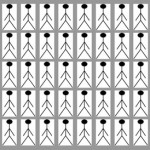Randomized Clinical Trials > Number Needed to Treat
What is Number Needed to Treat?

Examples
An NNT of 20 would mean that twenty people would need to be treated in order for one person to benefit. This may or may not be effective depending on what you are treating and whether or not the side effects are severe. For example, the flu vaccine has varying NNTs ranging from 12 to about 40. That means between 12 and 40 people would need to get the flu shot to prevent a single case of the flu. The fairly low NNT and an unproven ability to prevent hospitalizations or death is one reason why there is a lot of debate about whether the flu vaccine should be recommended at all. On the other hand, some chemotherapy agents have similar NNTs (between 17 and 34). However, as the end result of cancer is almost certain death, even preventing a few deaths is still a significant benefit.
Calculating NNT
If you know the absolute risk reduction (ARR) (the difference in the proportion of event rates in the treatment group compared to the proportion of event rates in the control group), you can easily calculate the NNT. That’s because the NNT is the inverse of the ARR:
NNT = 1 / ARR = 1 / (CER (Control Event Rate) – EER (Experimental Event Rate))
If all of the people in the treatment group have positive outcomes and none of the control group do, then the NNT equals 1. This is the ideal NNT, but it is rarely realized in real life.
You can also calculate NNT from an Odds Ratio using the table found here.